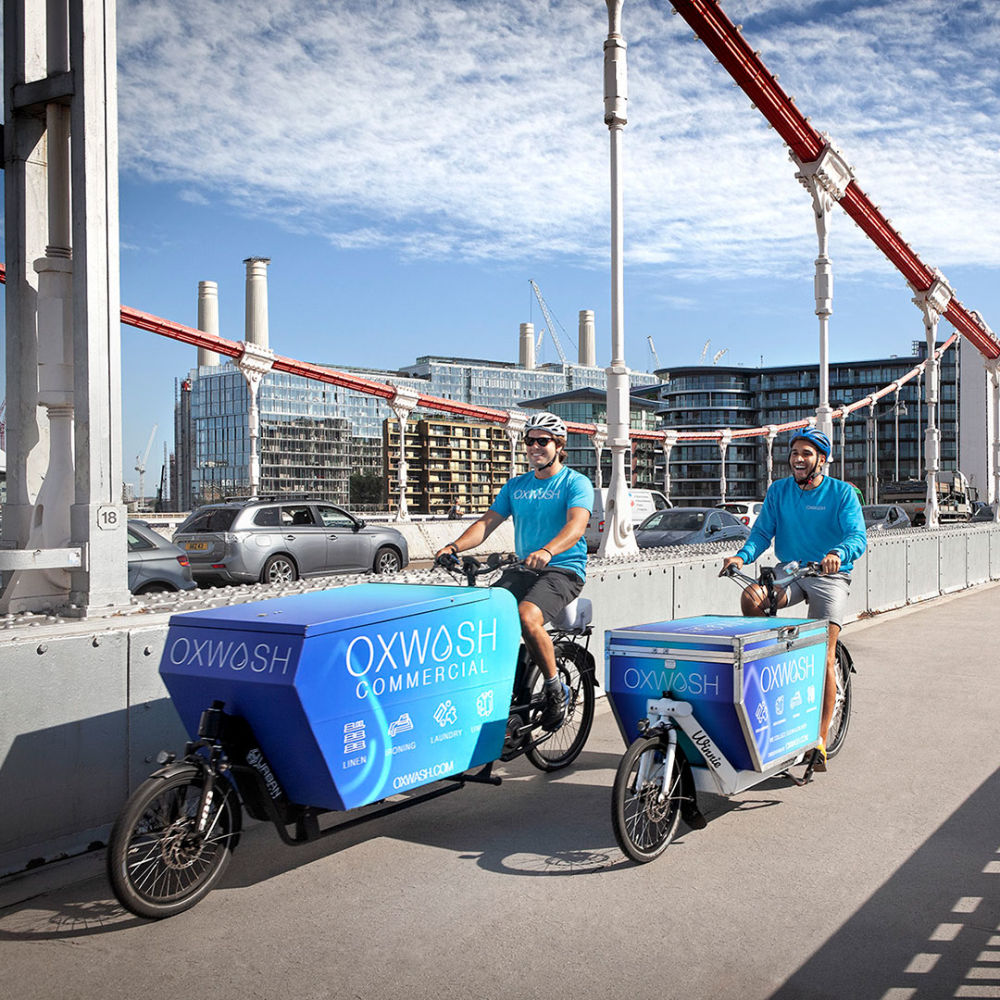Our sustainability report is now live and free to download!
Cleaning The Way We Wash One Load at a Time
Cleaning The Way We Wash One Load at a Time


Business & Insights
Oxwash is looking to shake up a broken laundry industry. They have set up several easy solutions to help minimise landry's impact on the environment. BBC Click's Chris Fox visited one of the company's lagoons in Battersea, London and asked founder Kyle Grant why people would want to send their clothes away to be washed.
We have surmised the findings below.
CO2e
At the moment, figures show that domestic laundry produces significant amounts of C02e. A single load of laundry at 60˚C, preceded by tumble drying, produces the equivalent of 3.3kg of CO2. Assuming the average household does a wash every other day, they would produce 603.9 kg of C02e each year.
We make sure that all washes are on the lowest heat possible. With our technology we save 1.4kg CO2 emissions per 8-kilogram wash. Our biodegradable detergents, coupled with our ozone integration, provide excellent results at a 20˚C as opposed to the standard 40˚C - 60 ˚C.
What is Ozone?
Ozone is a molecule that is usually found in the outer atmosphere, it protects us from UV! It is also used for deodorisation/disinfection for delicate and highly stained/soiled textiles.
Ozone cupboards can take surrounding air and convert it into 90% oxygen, this is then split into ozone and injected into the garment to disinfect it.
Risk of infection is an ever-present concern for many, especially for businesses in hospitality and medical industries. By using Ozone technology, Oxwash can guarantee that their washers are able to kill 99.9999% of infections in the cleaning process. Not only is this method the most innovative way to kill bacteria, mould and viruses, but it is also more environmentally efficient. It also means harsh chemicals can be avoided.
Water
Washing clothes requires large amounts of water - a single wash cycle requires anything between 50 - 80 litres of water! A study done by Oxwash, Vanish and The Prophets showed that washing machines in the UK use about 360 billion litres of water yearly - that’s enough to drain Lake Windermere!
Our washing machines have built-in reclamation tanks that allow us to store the last cycle’s water from one wash and use it as the first cycle on the next. This allows us to save 60% of the water consumption versus a typical commercial washing machine and 70% compared to a domestic washing machine.
Chemicals
Traditional laundry detergents are manufactured using synthetic chemicals and contain damaging chemicals including chlorine bleach, dyes, fragrances and optical brighteners which contaminate our waterways. Some detergents also contain phosphate and nitrogen which can cause algal blooms that starve other organisms from oxygen and sunlight.
Unfortunately, conventional dry cleaning is not the solution to delicate clothing care either. Dry cleaning, despite its name, is neither dry nor clean. It usually involves soaking clothes in a toxic perchloroethylene solvent, a human carcinogen which has been banned and phased out in some countries, including the US, since 2007. Workers exposed to perchloroethylene in dry cleaning facilities can suffer short term side effects such as dizziness, headaches and nausea and evidence suggests long term exposure can cause miscarriages and leukaemia.
Our biggest impact on the environment is the use of our cutting-edge technology in wet cleaning.
We are challenging the tired, old, traditional dry-cleaning process, with new innovative wet cleaning technology. It is just as effective but with none of the drawbacks of dry-cleaning.
Wet cleaning is a professional cleaning method that uses only water and biodegradable detergents and avoids the use of chemical solvents such as perchloroethylene or "perc".
Our machines have been adapted to achieve fourth generation wet cleaning capability. This means that the equipment we use can process both wet and dry clean-only items as well as standard laundry.
The machines calculate individual cycles for each type of fabric or garment type and the dosing of biodegradable detergents is dynamic and automated.
With wet cleaning technology we achieve clean and soft garments with minimum chemistry addition to our washing process.
Microfibers
Another huge issue with washing is the lack of filtration. Most common household washing machines have no filter. This means that when items with plastic fibres are being washed, they crash together and cause micro plastics to break up and cause issues in the waterways and oceans. Washing our clothes is predicted to release 500,000 tons of microfibers into the ocean each year. This is equivalent to 50 billion plastic bottles. The pollution of marine environments has become a global scale problem that is still greatly lacking in solutions. With the average household washing between 2 - 8 loads a week, it is only adding to the issue.
When you send your items to Oxwash they are able to be washed in our specialised machines that capture up to 1 million microfibers from every KG we wash. We're rapidly implementing microfibre filtration in 2022 to capture more than 95% of all the fibres shed during washing. This process prevents plastic pollution of our waterways and drinking water. One third of ALL ocean plastic are microfibres from our clothes, this has to stop.
Some other cutting-edge technologies include.
Oxwash uses a spotting table to remove those hard to lift stains. A spotting table has a water spray, steam gun and air gun. These tools enable us to blast stains loose from the affected garments without the use of harsh chemicals.
They also use a roller iron to dry iron and fold sheets and bedding in under a minute. This helps cut down the use of tumble dryers that use a huge amount of C02.
Related Articles


B Corp™ certified.


Surpassing NHS-grade disinfection.














